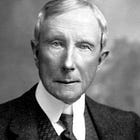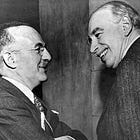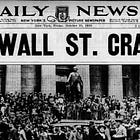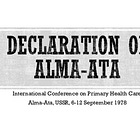The modern financial system isn't really built for stability in the way we're commonly told. Rather, it follows a hidden formula that repeats across every major crisis with mechanical precision:
Crisis → Intermediation → Conditionality → Control
This is a formula so consistent and effective that it should be discussed — especially given that it tends to operate entirely in the shadows. What is commonly referred to as ‘stability’ typically leads right to a tightly controlled clearing mechanism.
And commonly, chaos is an engineered pretext for establishing that control.
Executive Summary
A single institutional template — born from an 18th-century banking crisis — became the universal architecture of global control. The ‘clearinghouse protocol’ operates through a deceptively simple principle: whoever controls the final settlement layer controls the entire system, regardless of who owns the underlying assets.
The pattern emerged in 1772 when London bank clerks, facing payment system collapse, began meeting at a tavern to centrally clear all transactions. This improvised solution established three enduring precedents: settlement intermediation grants systemic power, network participation becomes functionally mandatory, and crisis provides political legitimacy for centralisation.
Over 250 years, this template scaled systematically. The 1844 Bank Charter Act eliminated currency competition in Britain, the 1913 Federal Reserve exported the model to America, and the 1930 Bank for International Settlements globalised central bank coordination. The 1944 Bretton Woods Conference formalised dollar dominance, making the Federal Reserve the planet's apex clearing authority.
But the protocol transcended finance. The same architects who designed monetary clearing systems explicitly advocated applying identical structures to international governance, health policy, climate regulation, and information control. From the League of Nations to WHO to social media content moderation, the clearinghouse template replicated across every domain of human organisation.
Today's global hierarchy — where central banks serve as ultimate clearing authorities for their currencies, all subordinate to Fed dollar dominance — represents the completed financial architecture. Meanwhile, parallel clearing systems govern legal disputes (UN), health policy (WHO), climate regulation (UNFCCC), and information flow (social media platforms). Each follows the same logic: crisis creates the pretext for intermediation, intermediation enables conditionality, and conditionality delivers control.
The clearing protocol succeeds not by winning competition, but by ending it. Understanding this template reveals the hidden architecture underlying seemingly unrelated institutions across finance, governance, health, climate, and information systems — all operating through the same fundamental mechanism of settlement control.
The Pattern Hidden in Plain Sight
In textbooks, clearinghouses and central banks are portrayed as neutral infrastructures which work to establish ‘stability’. In reality, when combined they instead seize power during alleged emergencies. When panic hits, the core infrastructure of settlement typically prepared years in advance — the clearinghouses — doesn't quite save the system, but rather it routes authority upward to the authorities of final settlement, who gradually displace ordinary rules and expand their grip.
At the heart of its logic lies a system of settlement through an intermediary. The objective is not ownership, it’s the insertion of a mechanism which controls flow. At each critical juncture this mechanism is inserted, with the ultimate objective not being winning a competition — but to terminate the competitors.
The story begins in 1772 in a London tavern1, further develops in 1844 with the elimination of monetary competition in Britain, spreads to America with the Federal Reserve in 1913, and culminates in today's dollar-dominated global hierarchy coordinated through the Bank for International Settlements.
This is the hidden architecture of global control: whoever controls the final settlement layer controls the world.
Genesis in Crisis - The 1772 Template
The template was born from catastrophe. In 1772-73, a banking panic shattered London's financial system when Alexander Fordyce2, a partner at Neale, James, Fordyce & Downe3, lost £300,0004 betting against the East India Company5 — a staggering sum at the time, triggering cascading bank failures across Europe. Within weeks, eight London banks collapsed and twenty more failed continent-wide. Contemporary accounts describe ‘the whole City in uproar, and many of the first families in tears’.
Until then, bank clerks had handled settlement by personally exchanging checks and keeping mutual ledgers. A clerk from Bank A would walk to Bank B, hand over checks, and the two would record debits and credits, settling up periodically. This old bilateral system failed to function during a panic. Once any bank's solvency was in doubt, other banks stopped exchanging checks or called them immediately, and the whole settlement mechanism froze. When the 1772 crisis hit, the system was on the verge of collapse.
The improvised solution was revolutionary: clerks began meeting daily at the Five Bells tavern on Lombard Street to exchange all their checks in one central location and calculate net balances6. Instead of dozens of bilateral settlements, all payments flowed through a single meeting point. This informal experiment proved so effective during the crisis that it was formalised as the London Bankers' Clearing House7.
The clearinghouse established three precedents that remain the foundation of financial control:
Intermediation Over Ownership: The clearinghouse didn't need to own bank assets to wield power — it simply controlled the settlement ledger where all balances were finally reconciled.
Network Lock-In: As the efficiency gains became clear, joining became essentially mandatory for any serious bank. Opting out meant competitive death.
Crisis Legitimacy: What might seem like dangerous centralisation in normal times looked like salvation during panic, providing political cover for further consolidation.
This wasn't just an innovation in payments technology. It was the birth of a new form of power: control through settlement rather than ownership.
The 1844 Coup - Ending Currency Competition
The clearinghouse solved interbank settlement, but the competitive currency landscape remained. Before 1844, the United Kingdom was a patchwork of competing currencies, with over 200 banks issuing each their own: The Bank of Manchester issued Manchester pounds, Yorkshire Banking Company issued Yorkshire pounds, and dozens of others operated as monetary sovereigns within their own territories.
Financial crises occurred — the Panic of 18258 sparked by speculative overinvestment in Latin America, the 1837 collapse9 that brought years of depression and mass unemployment. Whether these crises resulted from currency competition, speculative excess, international capital flows, or other factors became a matter of fierce debate. What mattered was that each crisis was used to discredit the competitive currency system and strengthen calls for centralisation.
Enter David Ricardo's10 intellectual framework11, which would shape both the consolidation and its eventual critique. Ricardo's currency theory argued that competition in money creation was inherently destructive; that uncontrolled note issuance caused inflation and instability12. The Currency School weaponised this theory to argue that monetary competition must be eliminated entirely13.
They succeeded spectacularly. The Bank Charter Act of 184414 systematically eliminated all competitors with time:
No new banks of issue could be created
All new notes required 100% backing in gold or government bonds
Any existing note-issuing bank lost that right if it merged or failed
Overnight, the Bank of England acquired a near-monopoly over Britain's money supply; legislative termination of all competition.
Yet, the Act included an escape clause allowing the government to suspend its own rules during emergencies. And suspend it they did — in 1847, 1857, and 1866. Each suspension pumped fresh currency into the system while the strict rules remained in place during normal times. This revealed the deeper function: ‘The solution to the last crisis becomes the precedent for suspension during the next’.
The Bank of England emerged from each crisis stronger and more indispensable than before, having proved that the rules were flexible when survival was at stake, but iron-clad when competitors might benefit. Through crisis-induced legislation, it consolidated apex authority over money issuance. And once in control, the Bank of England established a mechanism of suspension and expansion that would be replicated globally — while terminating its competition.
Ricardo's Dual Legacy - Arming Both Sides
David Ricardo inadvertently handed both the architects of financial monopoly and the revolutionaries their most powerful intellectual weapons.
Currency Theory → Monopoly Justification: Ricardo's argument that competitive note issuance caused inflation provided the theoretical foundation for the Currency School's assault on monetary competition. This justified the Bank of England's monopoly as scientifically necessary for stability.
Labor Theory → Convergent Structure: But Ricardo also argued that labor creates all value, which Karl Marx adopted in Das Kapital to demonstrate that capitalists systematically exploit workers. Yet Ricardo's advice on centralisation benefited both the BoE and communist revolutionaries equally, as the Communist Manifesto explicitly called for ‘centralisation of credit in the hands of the state, by means of a national bank with state capital and an exclusive monopoly’. Ricardo's intellectual framework thus justified the centralised clearing authority Marx and Engels advocated.
Ergo, Ricardo armed both the consolidators and the revolutionaries, creating simultaneous intellectual justifications for monopoly. The Currency School used Ricardo to eliminate monetary competition; Marx used Ricardo to reveal how that elimination served capital accumulation at labor's expense.
Yet, both appear strangely compatible.
The Settlement Layer - Bank of England Supremacy
By the mid-1800s, the Bank of England had become the ultimate power broker. Chartered in 1694 through the supply of a £1.2m government loan of in exchange for a banking monopoly, from its inception the BoE was in effect the state's treasury and payment agent. Over the 18th century it built up a reputation — by 1781 it was already called ‘the bankers' bank’ — because commercial banks increasingly held their reserves there. The bank honoured its notes on demand in gold, which made other banks want accounts with the BoE to assure their own customers.
This entrenched a tiered structure of clearing: local merchants and businesses banked at local or clearing banks; those banks held accounts at the Bank of England; and the Bank of England kept the ultimate cash (gold or reserves) on hand to settle all balances. In modern terms, the Bank of England became the final settlement layer for the entire country. Today this principle is formalised in real-time gross settlement (RTGS) systems15, where every major bank maintains a reserve account at its central bank to clear payments — and those who sit at the apex of that final clearing system holds ultimate power.
This settlement authority grants four critical powers that transform clearing from service to control mechanism. First, clearinghouses can refuse to clear specific transactions, effectively blocking financial flows regardless of account balances or legal ownership. Second, they can deny account access entirely, cutting institutions or individuals out of the payment system completely. Third, they impose conditions for participation — compliance requirements, reporting standards, behavioral restrictions — that participants must accept to maintain clearing privileges. Fourth, they can suspend services during declared ‘emergencies’, temporarily freezing the entire system while maintaining discretionary authority over who regains access and under what terms. These powers mean that control over clearing infrastructure grants effective veto authority over all economic activity that requires settlement — which, in a modern economy, is virtually everything. The Bank of England wielded these powers subtly but systematically, establishing the template for financial control that would be replicated globally.
Contemporary examples demonstrate these powers in action:
Transaction refusal: SWIFT blocked specific Russian banks from certain cross-border payments following 2022 sanctions16, while payment processors like PayPal have refused to handle donations to WikiLeaks17 and various political organisations.
Account denial: Iranian banks were completely cut off from SWIFT18 messaging during sanctions, effectively barring them from international finance.
Conditional participation: Basel III capital requirements force banks to meet specific ratios to maintain clearing privileges, while KYC/AML compliance has become mandatory for any institution seeking payment system access19.
Emergency suspension: During the 2022 Canadian trucker protests, banks froze accounts of protesters and donors without court orders20, while Cyprus imposed complete capital controls in 2013, temporarily suspending normal banking operations21.
Each example reveals the same principle: those who control settlement infrastructure can unilaterally restrict economic activity, regardless of legal ownership or constitutional protections. This power became institutionalised through the fundamental principle of modern monetary systems: the central bank of each nation serves as the ultimate clearing house for that currency, with all commercial banks ultimately settling through the central bank's ledger. A bank in France clears through the European Central Bank for euros (French Franc through the Bank of France in earlier days), a bank in Japan through the Bank of Japan for yen, and banks in America through the Federal Reserve for dollars. Each central bank controls the final settlement layer for its currency — making it the apex authority within that monetary zone.
We even have physical evidence of how central settlement became sovereign. The Bank of England built one of the world's largest gold vaults, now containing roughly 400,000 bars (worth over $200 billion)22. Remarkably, only about 6% of that gold belongs to the British government, with the rest held on behalf of foreign central banks and official institutions from around the world. Why? Because in times of trouble or issues of trust, countries want to park their gold with the world's premier settlement authority. In effect, nations entrust their wealth to a foreign bank when it serves as the safe clearinghouse. Those vaults aren't just treasure—they're physical proof of the BoE's ultimate role in global finance.
And we didn’t even discuss the truly heinous ‘In Tandem’ here.
Global Scaling - The Federal Reserve Adoption
The London template became highly successful. After repeated banking panics culminating in the devastating crisis of 190723, the United States created the Federal Reserve System in 1913, explicitly modelling it on the Bank of England. The twelve regional Reserve Banks functioned like Britain's clearing banks, with the Federal Reserve Bank of New York emerging as the dominant hub — London's analog in the New World.
The Fed's rise to global supremacy followed the established script., and soon the FedNY took on a global settlement role. Starting around 1916, the New York Fed began offering dollar accounts to foreign central banks. By 1924, it was literally taking custody of other nations' gold. But it was the 1944 Bretton Woods Conference24 which formalised what was already emerging: the dollar became the central clearing currency for international finance, and the Fed became the ultimate settlement authority for global transactions.
Over the 20th century, the U.S. dollar grew to dominate international finance25. Today roughly 60% of official foreign reserves are held in dollars, and about 85% of foreign-exchange trades involve USD on one side. In practice, this means the FedNY is the planet's de facto apex of clearing. Any central bank that wants access to dollars (to stabilise its own currency or pay foreign debts) must maintain a correspondent account at the New York Fed. That makes them similar to the primary dealers at home — entitled to liquidity at the Fed's window, yet ultimately dependent on it.
The dominance of the FedNY is clearest in crisis. During the 2008 global meltdown, the Federal Reserve extended its discount window and emergency swap lines to central banks from Europe to Asia26. During the alleged 2020 pandemic, the Fed did the same on an even larger scale, coordinating with the ECB, BoE, Bank of Japan, SNB and others to pour liquidity into the system via swap lines. In the U.S. banking stress of 2023 (the Silicon Valley and Credit Suisse crises), the Fed yet again stepped in. Within days, around $150 billion had flowed out of banks into Fed credit, even as foreign banks simultaneously tapped Fed swap lines for dollars. In every case, the scramble for safe money ended up at the New York Fed's door. This reinforced a simple truth: in the world financial system, crises channel everyone into the USD clearinghouse27.
In other words — the pattern is always the same: crisis creates dependence, dependence becomes structure, structure becomes control through conditional access. Comply, or get out of the business of banking.
International Coordination - The BIS Framework
The extension of clearinghouse logic to international finance was explicitly advocated decades before its implementation. In 1886, economist Julius Wolf first proposed an international gold clearing mechanism, developing this into a full public-private partnership model in his 1892 work Sozialismus und kapitalistische Gesellschaftsordnung28. That same year, Alfred de Rothschild — then a director of the Bank of England — developed material advocating international monetary coordination based on the London clearinghouse model. At the 1892 Brussels Monetary Conference29, Rothschild formally presented this framework30, praising the London bank clearinghouse as a proven template for international settlement.
Wolf's public-private clearing model developed further through the Marxist revisionist, Eduard Bernstein, in his 1899 Evolutionary Socialism31, proposing the application of a common good social purposes to the same institutional structure. Bernstein's gradualist approach earned mockery from Rosa Luxemburg and her fellow contemporary Marxists as ‘German Fabianism’32, revealing the ideological alignment between his revisionist socialism and the Fabian Society's institutional reform strategy. Yet, Bernstein’s model through Arthur Penty33 and GDH Cole’s34 Guild Socialism provided the theoretical foundation for Leonard Woolf's ‘International Government’35, which Alfred Zimmern used as a blueprint for implementing a political clearing mechanisms in the League of Nations36, with international organisations sapping power off sovereign nations through economic necessity, fuelled by what you’d today consider as neoliberal trade practices; open borders and tariff-free trading.
The institutional alignment is clear: the Bank of England's own leadership advocated scaling of the clearinghouse protocol to international setting nearly four decades before its implementation. And in 1930, the world's major central banks created the Bank for International Settlements, extending the clearinghouse model to central banks themselves. Driven by Montagu Norman of the Bank of England and Benjamin Strong of the New York Fed, the BIS presented itself as neutral coordination — a place for central banks to cooperate as equals.
In reality, the BIS institutionalised hierarchy. Its Board of Directors gives the United States two seats (the Federal Reserve System and the New York Fed separately) while most countries get one37. When the BIS arranges crisis lending, the actual funds come from the major central banks — the Fed, ECB, Bank of England, Bank of Japan, etc.
The BIS operates like a global operating system: it keeps the network running smoothly but doesn't rewrite who owns the hardware. It packages dollar dominance as multilateral cooperation while quietly preserving the USD-EUR-GBP hierarchy at its core: with the Federal Reserve, European Central Bank, and the Bank of England respectively
The Primary Dealer Model at Planetary Scale
Stepping back, the entire international finance system can be viewed as a three-tier network:
Retail Level: Commercial banks and financial firms clear transactions through their national system (e.g. banks on Fedwire in the U.S., or through clearinghouses domestically).
National Level: Central banks clear among themselves (e.g. the ECB, Fed, BoE, BoJ each provide liquidity in their currency).
Global Level: One dominant issuer (the Fed) stands at the top, providing ultimate settlement for everyone else via the dollar.
Other major currencies (the euro, yen, pound, Swiss franc) operate as their own networks but remain connected upward to the FedNY for dollars. In effect, central banks in the eurozone, Japan or Switzerland are regional franchisees for USD stability: they manage their currency in normal times but sign an invisible pact to follow the Fed's lead under stress.
The mechanics resemble the domestic primary dealer system. A domestic bank (like JPMorgan) keeps a reserve account at the Fed and can use the Fed's discount window. Likewise, a foreign central bank keeps an account at the FedNY and can tap Fed swap lines. During crises, these parallels become stark. In 2008, every one of the Fed's 14 swap-line partners lined up for funding (Europe, Canada, Japan, etc.)38. In 2020, a dozen more joined, and in 2023 when panic hit39, even central banks from Switzerland to New Zealand queued for dollar liquidity. Meanwhile, American banks further were scrambling at the Fed's domestic window. In all cases, the safety valve was ultimately the same place: the Fed's balance sheet.
No official scoreboard of ‘which currency is most powerful’ is published, but the stakes are clear. Roughly 60% of global reserves are in USD, about 20% in euros, and single digits in others40. More than 85% of trade finance and most cross-border deals are done in dollars or euros. Put bluntly, if you can't get dollars when needed, your economy risks grinding to a halt. That's why central bankers whisper about ‘monetary sovereignty’ — it really means having independent access to settlement without answering to New York or London.
London's Enduring Influence - Software vs. Hardware
Despite America's economic dominance, London retains what might be called ‘founder's privilege’. The City of London handles about 43% of global foreign exchange trading (versus 17% in New York)41, dominates the offshore Eurodollar market42, leads in derivatives trading43, and still sets the global price of gold daily44.
This reflects a division of labor: London created the financial ‘software’ — the protocols, conventions, and contract standards that govern global finance. New York provides the ‘hardware’ — the balance sheet capacity and currency that powers the system. The Bank for International Settlements manages the ‘operating system’ that coordinates between them.
London's continuing influence is visible in the Bank of England's vaults45, with these not just serving as treasure storage, but physical proof of London's role as the global clearing system's founding architect.
The Clearing Protocol
What emerges from this history is a radical reframing of financial power. Ultimate authority doesn't flow from owning the most assets, but from controlling the final settlement ledger — a fact, previously realised by Alexander Bogdanov. In modern finance, every transaction must eventually clear through a central authority; owning wealth means nothing if you can't convert it through the clearing system — a principle which scales down to the individual, experienced by those Canadians who had access to their own money cut by their personal financial clearinghouses during the trucker protest in 202246.
This principle reveals how the clearinghouse protocol systematically circumvents democratic governance. While citizens vote for representatives who debate policy in legislatures, real authority lies with unelected clearing authorities operating under technical mandates. Central banks, international bodies like the BIS, and payment processors wield decisive power without democratic accountability. Emergency conditions — from 1844's Bank Charter suspensions to COVID restrictions to trucker account freezing — allow these authorities to bypass normal legislative and judicial processes entirely. Complex financial operations are framed as requiring ‘expert’ management, placing crucial decisions beyond public understanding or democratic input. Meanwhile, access to basic economic participation becomes conditional on compliance with unelected authorities rather than being a democratic right. National sovereignty itself gets subordinated to international clearing hierarchies, making domestic democratic choices subject to external settlement control. The protocol succeeds precisely because it makes democratic oversight appear irrelevant to ‘technical’ operations, while those same operations determine who can participate in economic life.
This control over economic participation isn't accidental — it follows a systematic protocol that builds and operates every clearinghouse system through two phases: initial construction of the infrastructure, then the operational control mechanisms that govern it; a ten-step protocol which will be discussed in a future substack post.
The clearinghouse is the Trojan Horse of financial governance. It promises risk reduction but delivers centralisation, with each crisis justifying the next level of consolidation. And this clearinghouse is the economy's switchboard; who controls the switchboard wields ultimate leverage.
No crisis ever topple this structure, but entrench it. The 1844 Act's suspensions granted more power to the Bank of England. The crashes of 2008 forced central banks to expand their role (quantitative easing, new lending facilities) and governments to depend on them47. In 2020, direct central-bank financing of government budgets became mainstream48.
Each emergency has became an excuse to shift authority upward, and none of those powers are ever rolled back in full. In effect, crisis expansion has become the system's normal operating mode.
Today, a global hierarchy stands established where each central bank serves as the ultimate clearing authority for its currency: the Federal Reserve for the dollar, the Bank of England for the pound, the European Central Bank for the euro, the Bank of Japan for the yen. This principle explains the historical shift in power from London to New York over the twentieth century; as the dollar displaced the pound as the world's dominant reserve currency, the Federal Reserve became the planet's apex clearing authority, gradually making the New York Fed more powerful than the Bank of England in global finance49.
Yet this transition also reveals the enduring power of institutional legacy. London remains a financial capital of the world50 — not because Britain controls the dominant currency, but because it created the clearinghouse architecture that ultimately governs all currencies. New York might steal contemporary headlines, but London established the architecture of the global system.
National currencies — even ones that are technically independent like the euro or yen — during crises end up behaving like satellite nodes around the Fed's settlement hub. A eurozone bank might call the ECB lender-of-last-resort51, but when it needs raw dollars, it ultimately must turn to the Fed. The BIS and other forums keep the whole system humming, but they don't break this hierarchy, rather, they enforce it. Basel meetings are nice and multilateral, but they don't repatriate gold or reshape the dollar's dominance. The ‘clearinghouse coup’ that began in an 18th-century London pub is now essentially complete. Every country remains nominally free, but in the global financial arena, they're more like franchise branches of the Fed's clearing network, using the BoE legacy architecture.
Looking ahead, the same logic will apply even as technologies change. Whether finance moves to central bank digital currencies52, blockchain rails, or some new paradigm, the underlying fight will be for control of the clearing protocol — the rules and nodes where final settlement happens. Even attempts to escape the current system end up replicating its structure: BRICS has begun constructing BIS- and IMF-like clearing mechanisms53, but rather than creating alternatives, they're building competing clearing systems using the express same template54.
The protocol has even become the universal template for institutional capture across every domain of human organisation. The clearing protocol escaped finance and was quietly replicated across every domain of global governance. The 1907 Hague Convention55 established international legal clearing — standardised mechanisms for resolving disputes between nations rather than through bilateral negotiations or war. These legal clearing principles fused into the Versailles arrangements56 while Bernstein’s political clearing provided the foundation for Leonard Woolf's Fabian tract ‘International Government’57, which Alfred Zimmern then introduced at the League of Nations, later inherited by the United Nations.
But the international legal and political clearing mechanism established through the League58 ultimately proved toothless as the Second World War broke out59. The United Nations ‘fixed’ this by enhancing the clearing authority with enforcement mechanisms, operating as a more powerful global clearinghouse for sovereignty itself.
The pattern quietly replicated everywhere: health clearing was institutionalised in 1978 through the Declaration of Alma-Ata60, making WHO the global settlement authority for health policy. The alleged pandemic led to the Pandemic Treaty, which expands health crisis into the realm of biodiversity. Meanwhile, carbon dioxide clearing emerged through the UNFCCC in 1992, creating a planetary clearinghouse for climate governance. Public administration clearinghouses such as PACH 131361 centralised municipal governance standards, information clearinghouses like INFOTERRA consolidated knowledge flows through controlled access points, and ‘AI Ethics’ constraints62 control the distribution of information delivered through artificial intelligence. Ask a ‘wrongthink’ question and it will balk. Couple a personality profile, and information can be individually formatted in ways more manipulative. Integrate with BCIs, and even thought itself could eventually be cleared, perhaps through a future version of the ‘Disinformation Governance Board’63 with an expanded mandate?
Today, social media platforms operate as clearing mechanisms — Twitter manipulates information visibility based on content, thus functioning as a public discourse clearinghouse. The same principles apply: crisis legitimacy to expand control, intermediation over ownership, with eventual network lock-in down the road. But never direct ownership in itself. ‘Own nothing, Control everything’ after all.
Ultimately, the clearing protocol wins the competition by terminating the competitors, and the clearinghouse coup that began in an 18th-century London tavern is now essentially complete across every strata of human organisation.
The question now is who will own the apex of the system when the next crisis puts everyone back at the clearing desk.
To determine that fact, begin to investigate which frameworks are being established to prevent future crises. Or perhaps that framework was established in 2009, with ‘Planetary Boundaries’ gradually being shifted into position for when the future ‘meta-crises’ comes begging for a solution.
Resistance begins with awareness — only then can we reclaim control.
Keep reading with a 7-day free trial
Subscribe to The price of freedom is eternal vigilance. to keep reading this post and get 7 days of free access to the full post archives.
























